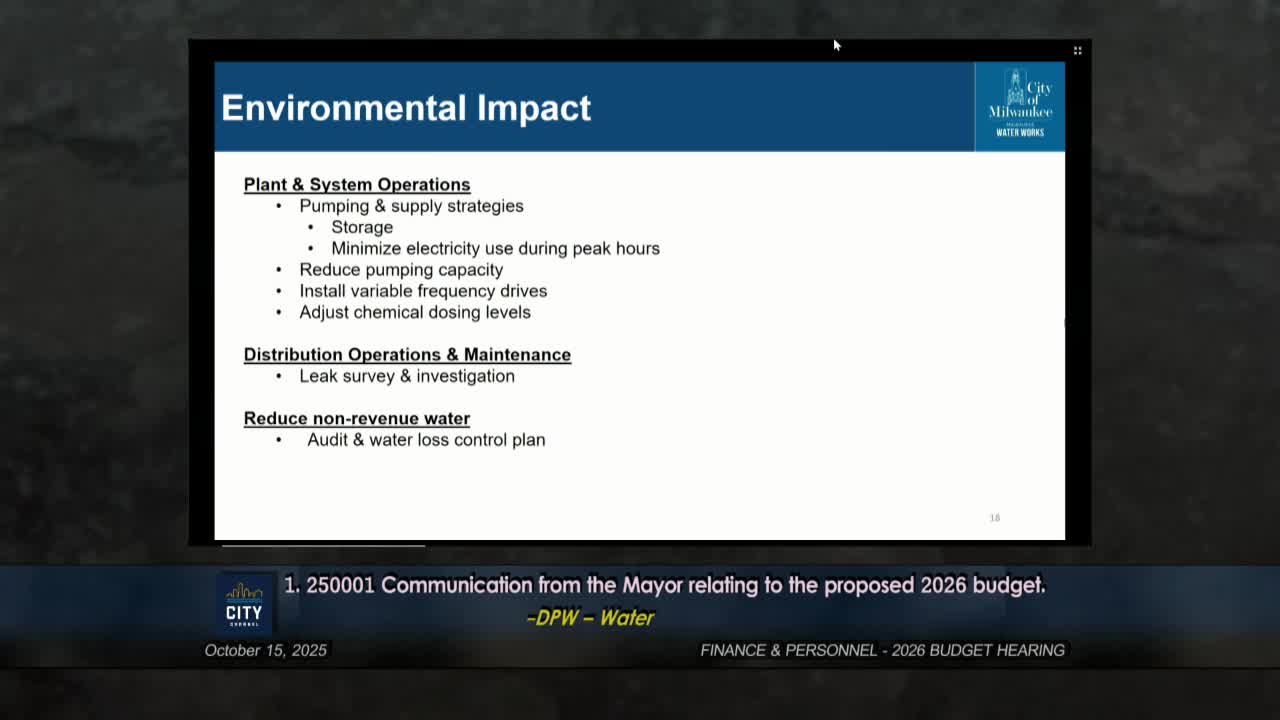Sewer maintenance fund keeps capital steady for green infrastructure and televising; department to staff an in‑house lateral replacement referral team
October 15, 2025 | Milwaukee , Milwaukee County, Wisconsin
This article was created by AI summarizing key points discussed. AI makes mistakes, so for full details and context, please refer to the video of the full meeting. Please report any errors so we can fix them. Report an error »

The Department of Public Works presented its 2026 Sewer Maintenance Fund budget with modest operating increases tied to higher construction‑supply costs and the cost of a revised Diggers Hotline share. Nathaniel Hack of the budget office described a cost‑to‑continue plan and a new small special fund to pay ongoing maintenance for green infrastructure rather than borrowing for recurring O&M.
Why it matters: DPW’s sewer group told aldermen it is prioritizing sewer condition inspections (closed‑circuit televising), constructing green solutions tied to stormwater goals and scaling a private‑lateral referral program that uses outfall testing results to identify leaking sanitary laterals on private property.
Key points
- Televising: The department aims to increase closed‑circuit televising to about 75–80 miles next year (projected 80 miles for 2026) as aging TV equipment was replaced and fleet capacity rose. Engineer‑in‑charge Kurt Sprangers told the committee, “We have a goal of about 75 miles this year; we should be able to hit that and 80 next year.”
- Green infrastructure: 2026 includes a proposed mix of bioretention beds, green alleys (roughly 10 planned), permeable pavers and curb bump‑outs as funding allows; DPW noted green projects are frequently paired with paving or multimodal projects.
- Maintenance special fund: DPW will move roughly $700,000 (previously borrowed) into a dedicated maintenance allocation for green infrastructure while keeping about $1.3 million for new construction in capital borrowing, preserving total green funding while avoiding borrowing for recurring maintenance.
- Private lateral program: The sewer group uses outfall sampling, smoke and dye testing to locate illicit discharges and leaky private laterals. The city has used MSD grants previously; DPW said it will continue referrals and replace privately owned laterals when identified through the city’s program.
Operational items and revenues
- Operating costs rose driven by construction supplies and a $500,000 increase tied to the city’s share of the Diggers Hotline calculation.
- Sewer and stormwater fees are proposed to rise around 3–4%; department representatives said revenue in 2025 has outpaced original budget projections.
Questions and next steps
Aldermen requested neighborhood‑level project lists and a clearer public timeline for televising and green‑infrastructure installations. DPW agreed to provide maps of planned green projects and to coordinate scheduling with paving and water‑utility work to avoid repeated street cuts.
Quote
“We are working to construct green infrastructure where we can… and we have a goal of roughly 80 miles of televising next year,” Kurt Sprangers said.
What the committee will watch
Contractor capacity for televising and green infrastructure, the pace of private‑lateral replacement work tied to federal/state grants, and the department’s ability to operate the new green‑infrastructure maintenance fund without future borrowing.
Why it matters: DPW’s sewer group told aldermen it is prioritizing sewer condition inspections (closed‑circuit televising), constructing green solutions tied to stormwater goals and scaling a private‑lateral referral program that uses outfall testing results to identify leaking sanitary laterals on private property.
Key points
- Televising: The department aims to increase closed‑circuit televising to about 75–80 miles next year (projected 80 miles for 2026) as aging TV equipment was replaced and fleet capacity rose. Engineer‑in‑charge Kurt Sprangers told the committee, “We have a goal of about 75 miles this year; we should be able to hit that and 80 next year.”
- Green infrastructure: 2026 includes a proposed mix of bioretention beds, green alleys (roughly 10 planned), permeable pavers and curb bump‑outs as funding allows; DPW noted green projects are frequently paired with paving or multimodal projects.
- Maintenance special fund: DPW will move roughly $700,000 (previously borrowed) into a dedicated maintenance allocation for green infrastructure while keeping about $1.3 million for new construction in capital borrowing, preserving total green funding while avoiding borrowing for recurring maintenance.
- Private lateral program: The sewer group uses outfall sampling, smoke and dye testing to locate illicit discharges and leaky private laterals. The city has used MSD grants previously; DPW said it will continue referrals and replace privately owned laterals when identified through the city’s program.
Operational items and revenues
- Operating costs rose driven by construction supplies and a $500,000 increase tied to the city’s share of the Diggers Hotline calculation.
- Sewer and stormwater fees are proposed to rise around 3–4%; department representatives said revenue in 2025 has outpaced original budget projections.
Questions and next steps
Aldermen requested neighborhood‑level project lists and a clearer public timeline for televising and green‑infrastructure installations. DPW agreed to provide maps of planned green projects and to coordinate scheduling with paving and water‑utility work to avoid repeated street cuts.
Quote
“We are working to construct green infrastructure where we can… and we have a goal of roughly 80 miles of televising next year,” Kurt Sprangers said.
What the committee will watch
Contractor capacity for televising and green infrastructure, the pace of private‑lateral replacement work tied to federal/state grants, and the department’s ability to operate the new green‑infrastructure maintenance fund without future borrowing.
View full meeting
This article is based on a recent meeting—watch the full video and explore the complete transcript for deeper insights into the discussion.
View full meeting
